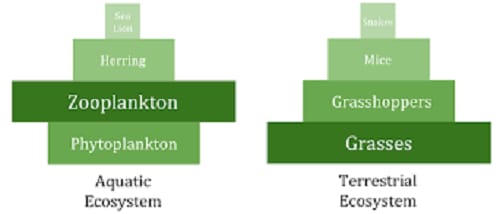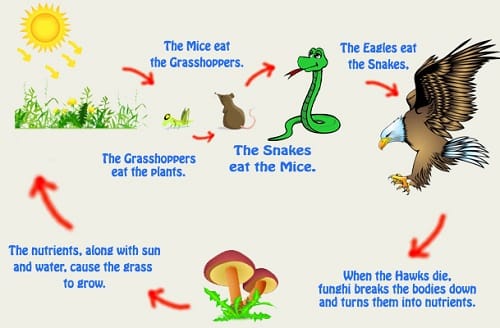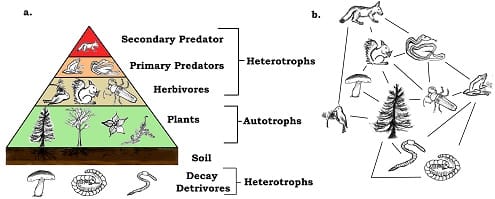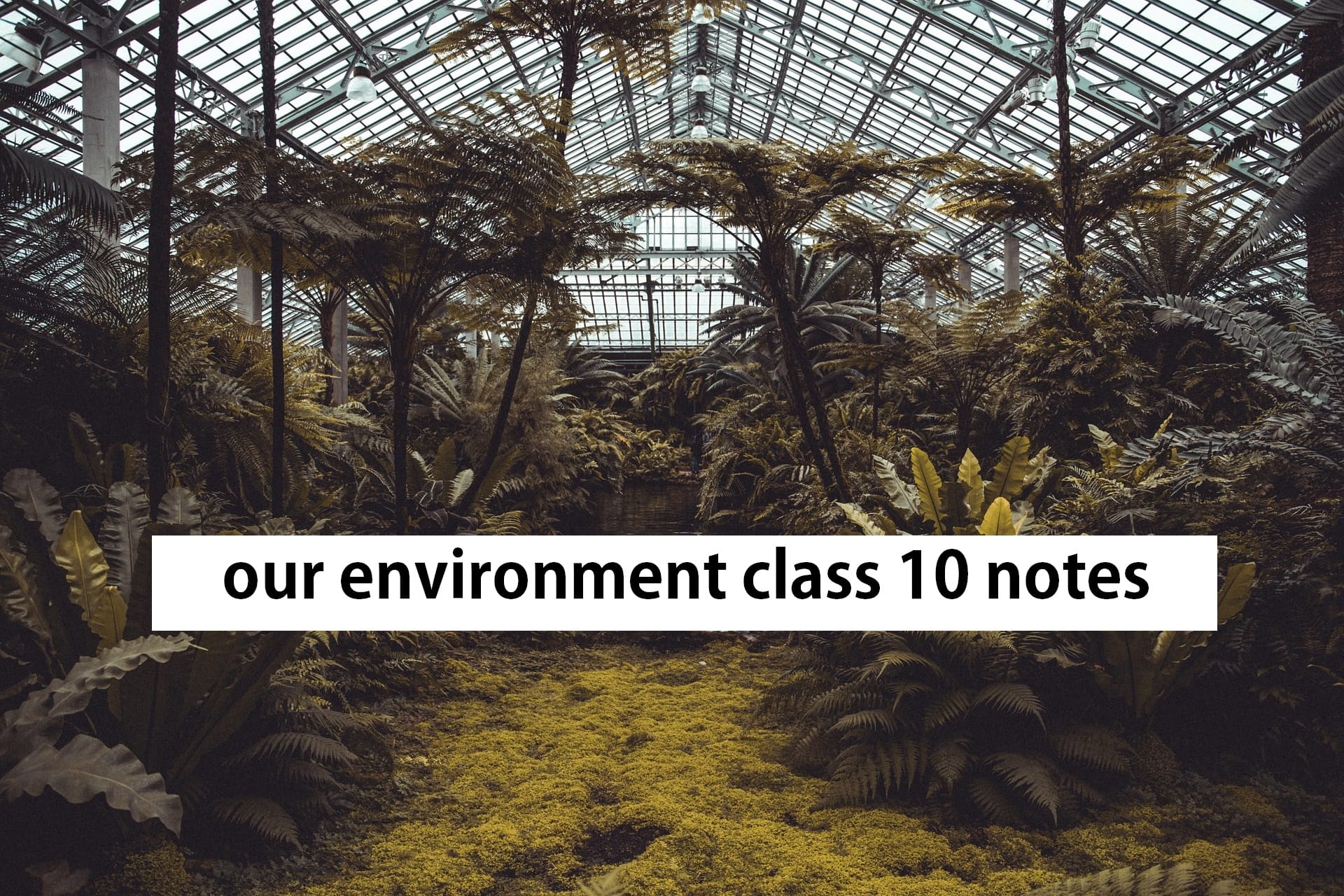Our environment class 10 notes comprise of Biodegradable and Non-biodegradable wastes, ecosystem and its components.
Our environment class 10 notes also comprise of the physical surroundings like air or atmosphere, water bodies, soil that includes plants, animals, human beings, bacterial, fungi, also known as decomposers. The waste materials formed by the various actions of man and animals are toxic to some level. The wastes are of two types:
- Biodegradable Wastes– Materials crushed down by the biological methods are known as biodegradable. These materials are decayed through the roles of fungi, bacteria, and the rest of the living organisms. The temperature and sunlight also play a major role in the destroying of biodegradable materials. Some of the examples are sewage agricultural remainder, paper, wood, cow-dung, etc.
- Non-Biodegradable Wastes– Materials that are not crushed down by biological methods are defined as non-biodegradable wastes. These materials can be in any form like gas, liquid, or solid. These materials are inactive and exist in the environment for a long time and may hurt several members of the ecosystem. Some of the examples are DDT, lead, arsenic, pesticides, insecticides, glass, plastic bags, etc.
Harmful effects of biodegradable and Non-Biodegradable Materials
- The leftovers harm natural beauty and make our environment dirty.
- Breakdown of these leftovers leads to the making of foul smell, which keeps on spreading in the environment from one place to another.
- The water gets blocked and results in the creation of waste which results in the formation of mosquitoes. Through these, mosquito’s people suffer from diseases like dengue and malaria.
On our environment class 10 notes, let’s read about the ecosystem and its components in a detailed form.
What is an Ecosystem?
An ecosystem is an independent unit of living things like plants, animals, and decomposers and non-living environments like soil, water, and air. Forest, lake, ponds, lakes, green lands are some examples.
It’s very important to remember that energy and matter keep on getting switched between living and non-living components. An ecosystem can be both human-made or just natural. Forest, lake, ponds, lakes, green lands are some examples of natural ecosystems.
Mountains, deserts, and grasslands are examples of the terrestrial ecosystem. The ponds, rivers, sea are examples of aquatic ecosystems. Aquariums, crop fields, etc. are examples of human-made ecosystems.
Now, there are two major components of the Ecosystem. These are Biotic and Abiotic components.
- Biotic Components– it consists of three types of organisms:
- Producers
- Consumers
- Herbivores
- Carnivores
- Parasite
- Omnivores
- Decomposers
- Producers: The green plants or the blue algae which can make their food through inorganic materials through the process of photosynthesis are defined as the producers. The other name for producers is autotrophs.
Planktons are very small organisms that float freely on the outside of a pond, river, or ocean. These are of two types which are 1. Phytoplanktons, and 2. Zooplanktons. The small marine plants that float openly outside the surface of the water are known as Phytoplanktons. and, the small marine animals which float on the water are known as Zooplanktons.
- Consumers: These are the creatures that chomp up other animals or creatures as their food. All the animals are present in this group. The consumers are very much dependent on the producers for their food. Goat, lion, fish, deer, cow, buffaloes, etc. are some of the examples of common consumers. They are now divided into Herbivores, Carnivores, Parasites, and Omnivores.

- Herbivores- Now, these are the animals that fill their stomach by consuming the plants or producers directly. Herbivores are told to be as the first order consumers. Deer, rabbit, squirrel, goat, cattle, etc. are some examples of herbivores.
- Carnivores– These are the animals that fill their stomach by consuming other animals. So, that means that carnivores feed on the herbivores’ flesh. These are known as second-order consumers. Jackal, frog, snake, wild cat, etc. are some examples of carnivores. Now, these are the animals that prey on primary consumers. They are known as second-order or third-order consumers. Owl, peacock, tiger, lion, etc. for example are some of the second-order carnivores and can be eaten up by third-order carnivores. The animals which are not eaten upon are known as the top carnivores—for example, Lion.
- Omnivores– The creatures which eat both plants and animals are known as omnivores. We, human beings, are the most common example of this category.
- Decomposers– fungi and bacteria which crumble the dead plants and animals’ complex mixtures into simple one are known as decomposers. The decomposers help in the renewal of natural resources which are known as microorganisms or are also known as reducers.
Importance of Decomposers:
- Decomposers help in arranging of the wastes and the dead bodies of plants and animals. So, they help us keep our environment clean and making a new place for the new generations of organisms.
- The decomposers also help us in maintaining the fertility of the soil. They generate minerals and raw materials stuck in organic matters. The plants pick these up.
- They produce acids that are useful for the solubilization of minerals.
- They help in renewing the materials in the biosphere, so the cycle of life and death goes on.
- Abiotic Components– They are the non-living components of an ecosystem. These majorly consists of the physical environment.
- Soil texture, water, air, and landscape.
- Carbon dioxide, nitrogen, oxygen, water, sodium, phosphorous, and calcium are included in the cycle of substances in the ecosystem.
- Proteins, carbohydrates, and lipids like organic compounds from the living body and relate the abiotic and abiotic components.
What are the functions of an Ecosystem?
- The ecosystem shows the available solar energy and proficiency of an ecosystem also to trap the solar energy.
- It provides you with information on the availability of important minerals and their renewal periods.
- It provides you with information about the relationship between the population and the abiotic environment.
- It also helps human beings in learning about the preservation of the resources, guarding against pollution, and contributions needed for major productivity.
- In the ecosystem, two ways of energy flows and biogeochemical cycles move side by side. The energy flow is unidirectional, whereas the flow of nutrients is cyclic.
On our environment-class 10 notes let us now read about the following things in details:
- Food chain
- Food web
- Trophic levels
- Depletion of the ozone layer
- Biological magnification
- Mode of waste disposal.
- Food Chain- The process in which one organism eats another organism for the flow of energy from one to another is known as the food chain. A food chain always works in one direction, i.e. it is unidirectional. It’s just a process that shows “who eats whom.” It also shows a procedure of various biotic groups in order of energy transfer. FOR EXAMPLE Grass – Deer – Lion
Examples of food chains are:
SIMPLE FOOD CHAIN: Grass (Producer) – Deer (Herbivore) – Lion (Carnivore)
Here, the grass is the first tropic level and is a producer. They prepare the food through photosynthesis. Deer eats the grass, which is known as herbivores or primary consumers. The lion eats the deer, which is known as a carnivore or secondary consumers. This can be shown as:
Grass, the Producers – Insect, the Herbivores – Frog, the Carnivores – Eagle, Secondary Carnivore.

Significance of Food Chains
- The study of food chains helps us in the understanding of the relationships and connections between different organisms in an ecosystem.
- The food chains help in transferring of energy and materials between different living components of an ecosystem.
- The movement of deadly substances like pesticides through food chains is very harmful.
- Food Web- A food web can be defined as the interconnected food chains working in an ecosystem that builds up a relationship between different species. You may find that one organism may be present in more than one food chain. An organism can get its food from anywhere and then can be eaten by another organism.

- Trophic Levels- The different steps in the food chain at which the transfer of food takes place is known as trophic levels. In a food chain, there is a steady drop in the amount of energy transferred from one trophic level to another. There’s only 10% of energy which gets transferred whereas 90% is used by present trophic level during life processes. There are four different trophic levels:
- First Trophic Level consists of the plants or producers.
- The second consists of herbivores or primary consumers.
- The third consists of Carnivores or secondary consumers
- Fourth Trophic Level- Large Carnivore is also known as tertiary consumers which eats the small carnivores.

- Depletion Of Ozone Layer- The ozone layer is the layer that is present in the stratosphere and is 12 km-50km above sea level. The region is known as the ozonosphere. At the ground level, this year is very harmful.
This layer acts as a protective layer for the earth and saves human beings from ultraviolet rays of the sun and also from skin cancer, weakened immune system, etc. Overuse of CFCs, inert chemicals like freon made this ozone layer in the upper atmosphere. A single atom can end 1,000 molecules.
- Biological Magnification- when there’s an increase in the concentration of harmful chemical materials like pesticides in living organisms at every trophic level, this is defined as biological magnification. For Example:
Grass (100 ppm) DDT – Deer (200ppm) DDT – Lion (5000ppm) DDT
Major awareness of the chemicals gathers down in human bodies.
- Garbage Disposal- Industrialisation and increasing demand for consumer goods have been highly responsible for the formation of wastes formation and then its removal in urban areas. People should learn the proper ways of waste disposal. The different methods are as follows:
- Incineration- this means burning off the waste at a high temperature and giving it an ash form. This is used to burn all households, biological, and chemical wastes.
- Open dumping- this method means to throw all the wastes in a selected place far away from the city.
- Land fillings- in this method, the garbage is thrown in the low living areas and is then rolled upon by the bulldozers.
- Recycling- the wastes in this method are used to form a new thing by breaking it down. Plastics, metals can be recycled.
- Reuse- a simple method to use garbage to make a new item again and again. Like, paper can be reused for making envelopes.
What are the harmful effects of agricultural performs on the environment?
- Extra usage of fertilizers ends up changing the chemistry of soil, therefore killing useful microbes.
- Extra usage of biodegradable chemical pesticides ends up to biological magnification.
- More and more cropping leads to the loss of soil fertility.
- More usage of groundwater in agriculture lowers the water table.
- Agricultural practices end up doing damage to the natural ecosystem.
On our environment-class 10 notes let us now read about the environment, its components, and ways for saving our environment.
- Environment- “The physical, chemical, and biological conditions of the region in which an organism life is called its Environment. It consists of air, light, soil, temperature, water.” There are three components of the environment:
- Physical Surroundings consists of soil, air, and water bodies.
- Living Organisms consists of Plants, decomposers, and animals.
- Meteorological Factors consist of Sunlight, temperature, rainfall, humidity, pressure, and speed of the wind.
- Physical Environment- Also known as an abiotic or non-living. This is essential for the supply of nutrient rudiments, giving space to the living organisms, and for controlling the weather of a place. It consists of:
- Water bodies, air, and soil present on the surface of the earth.
- Meteorological Factors.
- Biotic Environment- Also known as a biological environment consisting of plants, animals and human beings, and decomposers. Kites and vultures are also a part of this group as they eat the dead organisms and cleans the environment.
- A Generalised Food Chain-
SUN – PRODUCER – HERBIVORE – SMALL CARNIVORE – LARGE CARNIVORE –
Some examples of food chains on land could be:
- Grains – Sparrow – Cat.
- Grass – Rabbit – Hawk
- Cacti – Ants/Locusts – Spider – Lizard – Snake (desert)
Some examples of food chains in water could be:
- Algae (Phytoplankton) – Protozoa (Zooplankton) – Small Fish – Big Fish.
- Algae – Tadpoles – Small Fish – Big Fish.
- Algae – Mussel – – Small Fish – Big Fish.
- The flow of energy between different components of the environment-
- The green plants take about 1% of the energy and then change it into food.
- 1% of the food eaten turns into the body of organisms and makes it accessible for the next level.
- Each step has a 10% organic matter and then reaches the next level.
- Due to the little availability of the energy and food chain having only 3-4 levels, the next level lacks energy. So here, every step loses energy, and very little energy is left for the remaining.
- A greater number of people are present at the lower trophic level. There is the greatest number of producers.
